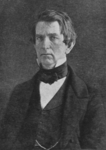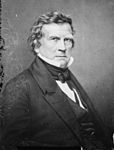
William Henry Seward was an American politician who served as United States Secretary of State from 1861 to 1869, and earlier served as governor of New York and as a United States Senator. A determined opponent of the spread of slavery in the years leading up to the American Civil War, he was a prominent figure in the Republican Party in its formative years, and was praised for his work on behalf of the Union as Secretary of State during the Civil War. He also negotiated the treaty for the United States to purchase the Alaska Territory.
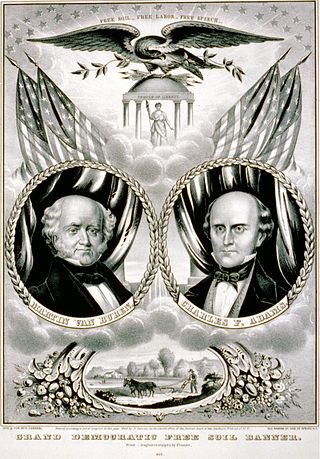
The Free Soil Party was a short-lived coalition political party in the United States active from 1848 to 1854, when it merged into the Republican Party. The party was largely focused on the single issue of opposing the expansion of slavery into the western territories of the United States.

The Fugitive Slave Act or Fugitive Slave Law was passed by the United States Congress on September 18, 1850, as part of the Compromise of 1850 between Southern interests in slavery and Northern Free-Soilers.
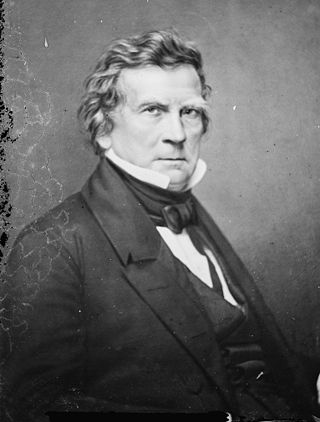
William Learned Marcy was an American lawyer, politician, and judge who served as U.S. Senator, Governor of New York, U.S. Secretary of War and U.S. Secretary of State. In the latter office, he negotiated the Gadsden Purchase, the last major acquisition of land in the contiguous United States.

Thomas George Pratt was a lawyer and politician from Annapolis, Maryland. He was the 27th governor of Maryland from 1845 to 1848 and a U.S. senator from 1850 to 1857.

George Nixon Briggs was an American lawyer and politician from Massachusetts. A Whig, Briggs served for twelve years in the United States House of Representatives, and served seven one-year terms as the 19th Governor of Massachusetts, from 1844 to 1851.

Luther Bradish was an American lawyer and politician who served two terms as Lieutenant Governor of New York from 1839 to 1842, while his Whig Party colleague, William H. Seward was governor. He was also co-founder of Children's Village.

The presidency of Millard Fillmore began on July 9, 1850, when Millard Fillmore became President of the United States upon the death of Zachary Taylor, and ended on March 4, 1853. Fillmore had been Vice President of the United States for 1 year, 4 months when he became the 13th United States president. Fillmore was the second president to succeed to the office without being elected to it, after John Tyler. He was the last Whig president. His presidency ended after losing the Whig nomination at the 1852 Whig National Convention. Fillmore was succeeded by Democrat Franklin Pierce.

The 1850 New York state election was held tuesday on November 5, 1850, to elect the Governor, the Lieutenant Governor, a Canal Commissioner, an Inspector of State Prisons and the Clerk of the Court of Appeals, as well as all members of the New York State Assembly.

The 1834 New York gubernatorial election was held from November 3 to 5, 1834 to elect the Governor and Lieutenant Governor of New York. This was the first fall election in which the Whig Party participated.
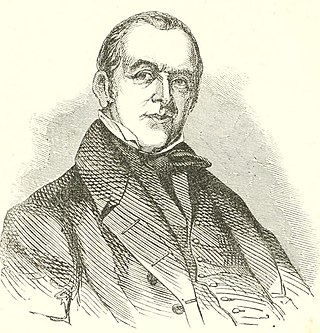
The 1836 New York gubernatorial election was held from November 7 to 9, 1836, to elect the Governor and Lieutenant Governor of New York.

The 1840 New York gubernatorial election was held from November 2 to 4, 1840, to elect the Governor and Lieutenant Governor of New York.

The 1842 New York gubernatorial election was held on November 8, 1842, to elect the Governor and Lieutenant Governor of New York.

Millard Fillmore was the 13th president of the United States, serving from 1850 to 1853, the last to be a member of the Whig Party while in the White House. A former member of the U.S. House of Representatives from upstate New York, Fillmore was elected as the 12th vice president in 1848, and succeeded to the presidency in July 1850 upon the death of Zachary Taylor. Fillmore was instrumental in passing the Compromise of 1850, a bargain that led to a brief truce in the battle over the expansion of slavery. He failed to win the Whig nomination for president in 1852 but gained the endorsement of the nativist Know Nothing Party four years later and finished third in the 1856 presidential election.

The 1839—1840 United States Senate election in New York was held on February 5, 1839 and January 14, 1840. Incumbent Senator Nathaniel P. Tallmadge was re-elected to a second term in office over scattered opposition.

The 1839 Massachusetts gubernatorial election was a tightly contested race won by Marcus Morton. Under Massachusetts law at the time, a majority of the votes cast was required to win, and Morton received exactly half the votes cast. Despite the presence of some irregularities, incumbent Whig Governor Edward Everett refused to contest the results once a legislative committee dominated by his party accepted a report giving Morton 51,034 votes out of 102,066 cast.

The 61st New York State Legislature, consisting of the New York State Senate and the New York State Assembly, met from January 2 to April 18, 1838, during the sixth year of William L. Marcy's governorship, in Albany.

The 62nd New York State Legislature, consisting of the New York State Senate and the New York State Assembly, met from January 1 to May 7, 1839, during the first year of William H. Seward's governorship, in Albany.

The 1854 Massachusetts gubernatorial election was held on November 15. American Party candidate Henry J. Gardner was elected to his first term as governor, defeating incumbent Whig Governor Emory Washburn.

The 1850–51 Massachusetts gubernatorial election consisted of an initial popular held on November 11, 1850 that was followed by a legislative vote that was conducted on January 11, 1851. It saw the election of Democratic Party nominee Emory Washburn. The ultimate task of electing the governor had been placed before the Massachusetts General Court because no candidate received the majority of the vote required for a candidate to be elected through the popular election.


